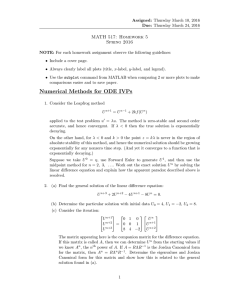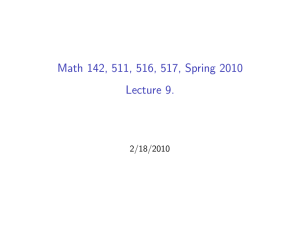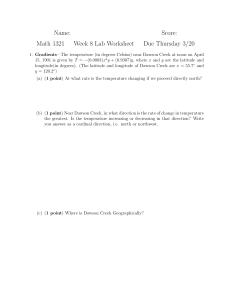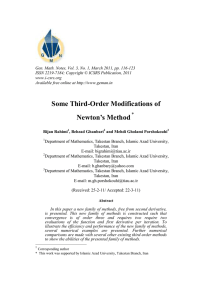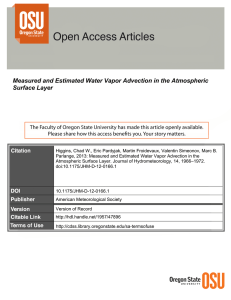MATH 517: Homework 7 Spring 2016
advertisement
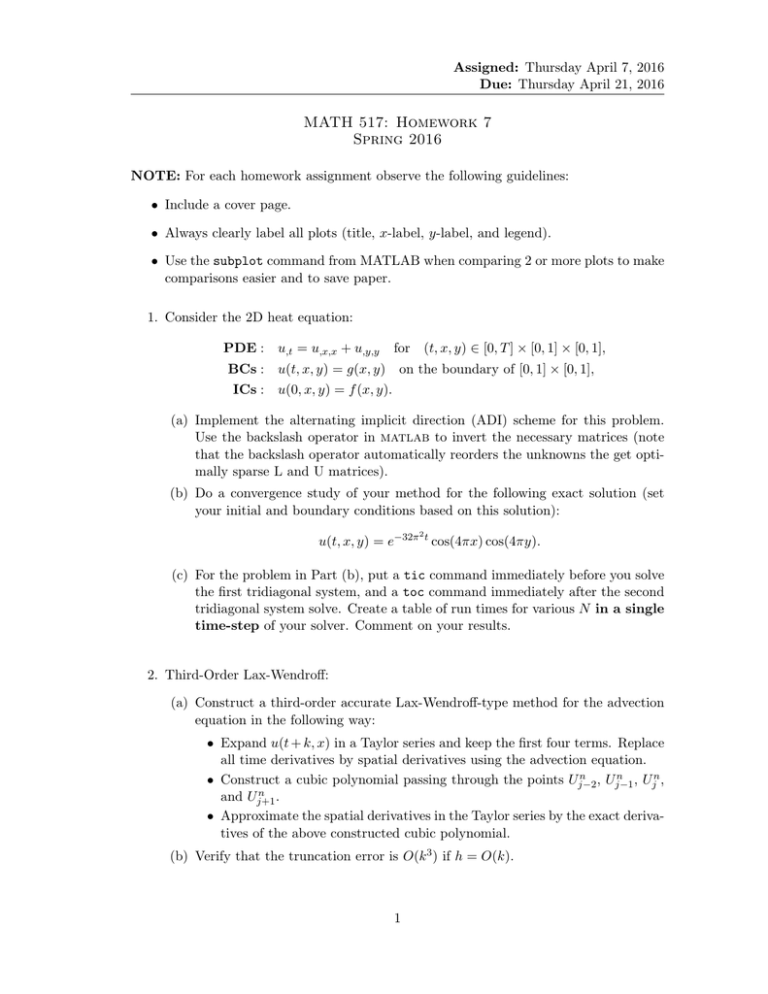
Assigned: Thursday April 7, 2016 Due: Thursday April 21, 2016 MATH 517: Homework 7 Spring 2016 NOTE: For each homework assignment observe the following guidelines: • Include a cover page. • Always clearly label all plots (title, x-label, y-label, and legend). • Use the subplot command from MATLAB when comparing 2 or more plots to make comparisons easier and to save paper. 1. Consider the 2D heat equation: PDE : u,t = u,x,x + u,y,y BCs : u(t, x, y) = g(x, y) for (t, x, y) ∈ [0, T ] × [0, 1] × [0, 1], on the boundary of [0, 1] × [0, 1], ICs : u(0, x, y) = f (x, y). (a) Implement the alternating implicit direction (ADI) scheme for this problem. Use the backslash operator in matlab to invert the necessary matrices (note that the backslash operator automatically reorders the unknowns the get optimally sparse L and U matrices). (b) Do a convergence study of your method for the following exact solution (set your initial and boundary conditions based on this solution): 2 u(t, x, y) = e−32π t cos(4πx) cos(4πy). (c) For the problem in Part (b), put a tic command immediately before you solve the first tridiagonal system, and a toc command immediately after the second tridiagonal system solve. Create a table of run times for various N in a single time-step of your solver. Comment on your results. 2. Third-Order Lax-Wendroff: (a) Construct a third-order accurate Lax-Wendroff-type method for the advection equation in the following way: • Expand u(t + k, x) in a Taylor series and keep the first four terms. Replace all time derivatives by spatial derivatives using the advection equation. n , U n , U n, • Construct a cubic polynomial passing through the points Uj−2 j−1 j n and Uj+1 . • Approximate the spatial derivatives in the Taylor series by the exact derivatives of the above constructed cubic polynomial. (b) Verify that the truncation error is O(k 3 ) if h = O(k). 1 Assigned: Thursday April 7, 2016 Due: Thursday April 21, 2016 3. Third-Order Method of Lines with RK3: The following method is a third-order accurate Runge-Kutta method for u0 = f (u): k U n+1 = U n + (2Y1 + 3Y2 + 4Y3 ) , 9 1 3 n n Y1 = f (U ) , Y2 = f U + kY1 , Y3 = f U n + kY2 . 2 4 (a) Construct a third-order accurate method for the advection equation in the following way: n , U n , U n, • Construct a cubic polynomial passing through the points Uj−2 j−1 j n and Uj+1 . • Approximate ux in the advection by exactly differentiating the constructed cubic polynomial. • Apply to the resulting semi-discrete system the above described RK3 method. (b) Verify that the truncation error is O(k 3 ) if h = O(k). (c) Plot the region of absolute stability of the RK3 method. Based on this plot, explain why RK3 is an appropriate method for the advection equation, while forward Euler is not. 4. Implement the methods from problems 3 and 4 on the advection equation on [0, 1] with periodic boundary conditions and a = 1. Run both methods on the initial conditions 1 2 u(0, x) = 2e−200(x− 2 ) . and 1 2 u(0, x) = 2e−200(x− 2 ) cos(40πx). Verify the order of accuracy of both methods. Briefly describe advantages and disadvantages of each of these methods – consider such things as accuracy, stability, efficiency, ease of derivation, ease of implementation, applicability to more complicated problems, etc . . . 2
